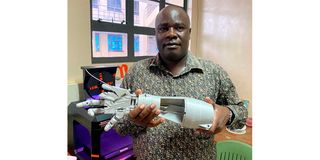Breaking News: KDF chopper crash kills five
MMUST, German varsities introduce 3D-printing technology

Dr Patrick Okoth, the lead project coordinator and lecturer at Masinde Muliro University shows some of the innovations that can aid in medical research.
Researchers at Masinde Muliro University of Science and Technology have developed 3D-printing technology known as stereo lithography that seeks to aid in medical research and other sectors like the manufacturing.
Through the project, they develop prototypes of biological macromolecules and make models for human parts like prosthetic arms, human brain, breasts and teeth, which have applications in medicine. The models are used for teaching as 3D-printing technology gains traction in the African continent.
Through the technology surgical simulations will be used to enable surgeons learn new techniques or prepare for specific operations without the use of patients, cadavers, or animal models. Through physical recreation of a patient’s organs or tissues, a realistic surgical procedure can be simulated.

A 3D printer.
The project is undertaken with collaboration between the university and two German universities; University of Magdeburg and Bradenburg University of Applied Science with funding from the German government through the German Academic Exchange Service (DAAD). It is conducted under practice-oriented teaching based on the German model.
“We can get the 3D-print out of human brain or human heart so that the surgeon can study it before a surgery. Adoption of new and innovative ideas in clinical practice is fundamental. 3D models help our surgeons with precision to avoid life threatening errors during surgeries,” Dr Patrick Okoth, the lead project coordinator and a lecturer of molecular biology, computation of biology and biometrics at the university told the Higher Education.
Health services
With devolution of health services, there is a huge gap in the adoption of 3D prototyping as means of pre-operative surgery. In most cases, surgeons rely on their past training and experiences as well as visual aids from medical imaging techniques such as magnetic resonance imaging (MRI) or computed tomography (CT) to guide surgical operations.
With recent advancements in the field of 3D-printing, MRI or CT images can be used to fabricate 3D anatomical models. 3D printing is a process by which 3D digital (CAD) models are converted into physical models through a layer-by-layer fabrication process. Patient-specific printed models of the anatomical region in need of surgical repair provide the surgeon with a better visualisation of the defected tissue, thus helping him to prepare for the surgery.
“Often, due to the anatomical complexity of the surgery site, two dimensional or virtual images are not sufficient to successfully convey the structural details. For such scenarios, a 3D-printed model of the patient's anatomy enables personalised pre-operative planning,” he added.

3D printer with a printed human heart.
The 3D-printing entails, first, configuring the slicing software such as ultimaker Cura with the 3D printer, which then creates 3D computer-aided design model of the intended printing file such as respirator, using software such as tinkercad or autocad.
Stereo-lithography
“The model is then converted to stereo-lithography by using the software used in the design phase, slicing the file to generate a G-code, the 3D printing each component of the desired model and lastly, the assembling of the individual components to obtain the desired model,” he explains.
The relatively new technology in African continent has a wide array of applications but majorly in medicine, robotics, engineering and industry.
“We are trying to set up the infrastructure and thereafter pursue the necessary approvals from the regulators. Currently, we use them for teaching and research. The project hopes to leverage on the existing technical expertise from our biotechnology students to roll out mass production,” Dr Okoth said.
Aside from generating teaching aids, he explained that they are developing the models for the school of medicine at the institution.
“Ideally, there are many teaching resources that can be printed using stereo lithography to aid in teaching so that learning is interactive. Students also learn computational techniques and design,” he said.





